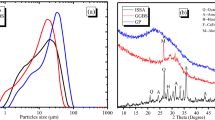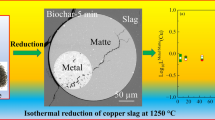Abstract
Green liquor dregs (GLD), a residual product from sulfate paper mills, was blended with tailings, fly ash, and bark sludge with the aim of improving the material’s physical properties so that it could function as a sealing layer in dry covers on sulfidic mine waste. Geotechnical and geochemical investigations, including weathering cell tests, were carried out on GLD with admixtures to assess their effectiveness. Due to its alkaline character, GLD was shown to have the potential to improve leachate quality by decreasing metal mobility when blended with tailings. The admixtures showed favorable sealing layer properties such as high water retention capacity and low hydraulic conductivity. However, caution must be exercised when the dregs are blended with tailings containing large amounts of As and Mo, since increased leaching of these elements may be expected.
Zusammenfassung
Grünlaugenschlamm (GLD), ein Abprodukt der Papierherstellung nach dem Sulfatverfahren, wurde mit Tailings, Flugasche und Rindenschlamm mit dem Ziel gemischt, dessen physikalische Eigenschaften zu verbessern, um ihn als Dichtschichtmaterial beim Bau von Abdecksystemen für sulfidische Bergbaurückstände verwenden zu können. Hierzu wurden geotechnische und geochemische Untersuchungen, darunter ein spezieller Labor-Elutionstest, an Rezepturen von GLD mit verschiedenen Zusatzstoffen durchführt. Wird GLD mit Tailings verschnitten, ist er aufgrund seiner Alkalität grundsätzlich geeignet, die Sickerwasserbeschaffenheiten infolge verringerter Metallmobilitäten zu verbessern. Die untersuchten Rezepturen wiesen positive Dichtschichteigenschaften auf, so ein hohes Wasserrückhaltevermögen und eine geringe hydraulische Durchlässigkeit. Allerdings ist Vorsicht geboten, wenn GLD mit Tailings verschnitten wird, die hohe Gehalte an As und Mo aufweisen, da es hierdurch zu einer Mobilitätserhöhung dieser Elemente kommen kann.
Resumen
El licor verde residual (GLD), un producto residual en las fábricas de papel por el método sulfato, fue mezclado con colas, cenizas volátiles y lodo de cortezas con el objetivo de mejorar las propiedades físicas del material para ser usado como una capa de sellado en cobertores secos sobre residuos de una mina de sulfuros. Investigaciones geotécnicas y geoquímicas, incluyendo los test de células de desgaste, fueron realizadas con GLD y diferentes agregados a fin de relevar su efectividad. Debido a su carácter alcalino, GLD mostró potencial para mejorar la calidad del lixiviado disminuyendo la movilidad de los metales cuando se mezcló con las colas. Los agregados mostraron propiedades favorables para ser usados como capas sellantes con una alta capacidad de retención de agua y baja conductividad hidráulica. Sin embargo, deben ser observadas ciertas precauciones cuando los residuos son mezclados con colas que contienen altas cantidades de As y Mo ya que puede esperarse un incremento de la lixiviación de estos elementos.
抽象
绿液渣(GLD)是硫酸盐造纸厂的固体废物。本文将绿液渣与尾矿、粉煤灰和树皮泥混合,旨在提高混合材料的物理性能,以作含硫化物尾矿堆的保护盖层。通过绿液渣(GLD)及其混合物的岩土力学试验、地球化学试验(包括模拟风化箱试验)评价其作为盖层材料的阻渗、防氧化效率。绿液渣呈碱性,与尾矿混合后能降低尾矿金属离子活性,减少滤出液离子含量,提高滤出液质量。绿液渣混合物表现出了高持水能力和低渗透性的良好盖层特性。但是,应当注意,当绿液渣与含有大量砷和钼的尾矿混合时,这些元素溶出量也会增加。



Similar content being viewed by others
References
Bellaloui A, Chtaini A, Ballivy G, Narasiah S (1999) Laboratory investigation of the control of acid mine drainage using alkaline paper mill waste. Water Air Soil Pollut 111(1–4):57–73
Bradham WS, Caruccio FT (1997) Sensitivity analysis of acid mine drainage prediction leaching tests. In: Proceedings of National Mtg of the American Soc for Surface Mining and Reclamation, pp 410–423
Brennan EW, Lindsay WL (1996) The role of pyrite in controlling metal ion activities in highly reduced soils. Geochim Cosmochim Acta 60(19):3609–3618
Brookins DG (2008) Eh-pH diagrams for Geochemistry. Springer, Berlin
BSI (2006) BS EN ISO 14688-2:2004: Geotechnical investigation and testing—identification and classification of soil. Principles for a classification. BSI, Milton Keynes
Carlsson E (2000) Geochemical effects of soil cover remediation on suphide-rich tailings at the Kristineberg mine, northern Sweden. Licentiate thesis. Luleå University of Technology, p 43
Chtaini A, Bellaloui A, Ballivy G, Narasiah S (2001) Field investigation of controlling acid mine drainage using alkaline paper mill waste. Water Air Soil Pollut 125(1–4):357–374
Cruz R, Méndez BA, Monroy M, González I (2001) Cyclic voltammetry applied to evaluate reactivity in sulfide mining residues. Appl Geochem 16:1631–1640
Dold B (2003) Speciation of the most soluble phases in a sequential extraction procedure adapted for geochemical studies of copper sulfide mine waste. J Geochem Explor 80:55–68
Gleisner M, Herbert RB Jr (2002) Sulfide mineral oxidation in freshly processed tailings: batch experiments. J Geochem Explor 76:139–153
Hakkou R, Benzaazoua M, Bussière B (2008) Acid mine drainage at the abandoned Kettara mine (Morocco): 2. mine waste geochemical behavior. Mine Water Environ 27:160–170
Hamberg R, Maurice C, Qureshi A, Jia Y, Mäkitalo M (2013) Characterization of green liquor dregs for mine waste remediation. Available SP Processum (in Swedish)
Hargelius K (2008) Pilotyta med tätskikt på Ätrans deponi- Fältförsök-Värö-FAVRAB-Hylte. Ramböll Sverige AB, region väst, Gothenburg (in Swedish)
Höglund LO, Herbert R, Lövgren L, Öhlander B, Neretnieks I, Moreno L, Malmström M, Elander P, Lindvall M, Lindström B (2004) MiMi—performance assessment—main report. MiMi report 2003:3, ISBN: 91-89350-27-8
Holmström H, Salmon UJ, Carlsson E, Petrov P, Öhlander B (2001) Geochemical investigations of sulfide-bearing tailings at Kristineberg, northern Sweden, a few years after remediation. Sci Total Environ 27:111–133
Jean GE, Bancroft GM (1986) Heavy metal adsorption by sulphide mineral surfaces. Geochim Cosmochim Acta 50:1455–1463
Jia Y, Stenman D, Mäkitalo M, Maurice C, Öhlander B (2013) Use of amended tailings as mine waste cover. Waste Biomass Valor 4(4):709–718
Jönsson J (2003) Phase transformations and surface chemistry of secondary iron minerals formed from acid mine drainage. PhD thesis, Departmentt of Chemistry, Umeå University, Sweden
Luther GW III (1987) Pyrite oxidation and reduction: molecular orbital theory considerations. Geochim Cosmochim Acta 51:3191–3199
Mäkitalo M, Jia Y, Maurice C, Öhlander B (2014) Characterization of green liquor dregs, potentially useful for prevention of the formation of acid rock drainage. Minerals 4:330–344
Maurice C, Mäkitalo M, Villain L, Öhlander B (2010) Green liquor dregs for the amendment of tailings. In: Proceedings of 13th international seminar on paste and thickened tailings, pp 487–494
Müller B, Axelsson MD, Öhlander B (2002) Adsorption of trace elements on pyrite surfaces in sulfidic mine tailings from Kristineberg (Sweden) a few years after remediation. Sci Total Environ 298:1–16
Parkhurst DL, Appelo CAJ (1999) User’s guide to PHREEQC (version 2)—a computer program for speciation, batch-reaction, one-dimensional transport, and inverse geochemical calculations. USGS WRI Report 99-4259, US Department of the Interior, Denver, CO
Peterson CR, Slamovich EB (1999) Effect of processing parameters on the morphology of hydrothermally derived PbTiO3 powders. J Am Ceram Soc 82:1702–1710
Rohwerder T, Gehrke T, Kinzler K, Sand W (2003) Bioleaching review part A: progress in bioleaching: fundamentals and mechanisms of bacterial metal sulfide oxidation. Appl Microbiol Biotechnol 63:239–248
Sánchez España J, López Pamo E, Santofimia E, Aduvire O, Reyes J, Barettino D (2005) Acid mine drainage in the Iberian Pyrite Belt (Odiel river watershed, Huelva, SW Spain): geochemistry, mineralogy and environmental implications. Appl Geochem 20:1320–1356
Schippers A (2004) Biogeochemistry of metal sulfide oxidation in mining environments, sediments and soils. In: Amend JP, Edwards KJ, Lyons TW (eds), Sulfur biogeochemistry—past and present, GSA Special Paper, Boulder, CO, USA, Geol Soc America, pp 49–62
Schippers A, Sand W (1999) Bacterial leaching of metal sulfides proceeds by two indirect mechanisms via thiosulfate or via polysulfides and sulfur. Appl Environ Microbiol 65:319–321
SIS (1991) Geotechnical tests-compression properties—oedometer test, CRS test cohesive soil. SS 02 71 26, Swedish Standards Institute, SIS förlag AB, Stockholm (in Swedish)
SIS (Swedish Standards Institute) (1981) Determination of dry matter and ignition residue in water, sludge and sediment. SIS Förlag AB SS 028113, Stockholm, Sweden
Siu T (1999) Kinetic and mechanistic study of aqueous sulfide-sulfite-thiosulfate system. MSc Thesis, Department of Chemical Engineering and Applied Chemistry, University of Toronto, Canada
Sobek AA, Schuller WA, Freeman JR, Smith RM (1978) Field and laboratory methods applicable to overburdens and minesoils. US Environmental Protection Agency, EPA-600/2-78-054, pp 47–50
Swedish EPA (2012) Naturvårdverket (Swedish Environmental Protection Agency). Avfall i Sverige. Report 6520, Bromma, Sweden (in Swedish)
US EPA (1991) Methods for the determination of metals in environmental samples. US Environmental Protection Agency, Office of Research and Development EPA/600/4-91/010, Washington, DC
Villeneuve M, Bussière B, Benzaazoua M, Aubertin M, Monroy M (2003) The influence of kinetic test type on geochemical response of low acid generating potential tailings. In: Proceedings of 10th international conference on tailings and mine waste: tailings and mine wastes’03, AA Balkema Publ, Rotterdam, pp 269–279
Wang S, Wu H (2006) Environmental-benign utilisation of fly ash as low-cost adsorbents. J Hazard Mater 136:482–501
Wang X, Forssberg KSE, Bolin NJ (1989) Adsorption of copper (II) by pyrite in acidic to neutral pH media. Scand J Metall 18:262–270
Zopfi J, Ferdelman TG, Fossing H (2004) Distribution and fate of sulfur intermediates—sulfite tetrathionate, thiosulfate, and elemental sulfur—in marine sediments. In: Amend JP, Edwards KJ, Lyons TW (eds) Sulfur biogeochemistry—past and present. GSA Special Paper, Geol Soc America, pp 97–116
Acknowledgments
The authors thank the Swedish Research Council for Environment, Agricultural Sciences and Spatial Planning (FORMAS ID 2008-268-12239-54), the European Union Structural Funds, the Northern Sweden Soil Remediation Centre, EDF Objective 2, Contract MCN IO No 43173, Sveriges Ingenjörers environmental fund, Norrbotten research council, and the Center of Advanced Mining and Metallurgy (CAMM) for financial support.
Author information
Authors and Affiliations
Corresponding author
Rights and permissions
About this article
Cite this article
Mäkitalo, M., Stenman, D., Ikumapayi, F. et al. An Evaluation of Using Various Admixtures of Green Liquor Dregs, a Residual Product, as a Sealing Layer on Reactive Mine Tailings. Mine Water Environ 35, 283–293 (2016). https://doi.org/10.1007/s10230-015-0340-x
Received:
Accepted:
Published:
Issue Date:
DOI: https://doi.org/10.1007/s10230-015-0340-x




